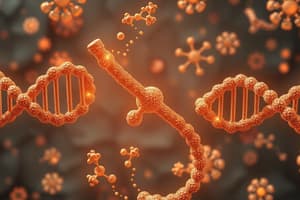Podcast
Questions and Answers
What is the primary function of mRNA in the central dogma of molecular biology?
What is the primary function of mRNA in the central dogma of molecular biology?
- To provide a template for protein synthesis (correct)
- To modify existing proteins
- To synthesize DNA
- To carry amino acids to the ribosome
Nucleotides are composed of a base, a sugar, and a phosphate group.
Nucleotides are composed of a base, a sugar, and a phosphate group.
True (A)
What type of bond connects nucleotides in a nucleic acid strand?
What type of bond connects nucleotides in a nucleic acid strand?
Phosphodiester bond
In DNA, adenine pairs with ______.
In DNA, adenine pairs with ______.
Match the following components with their descriptions:
Match the following components with their descriptions:
Which form of DNA is characterized by a right-handed helix with 10 base pairs per turn?
Which form of DNA is characterized by a right-handed helix with 10 base pairs per turn?
Z DNA is a left-handed helix composed mainly of alternating purine-pyrimidine nucleotides.
Z DNA is a left-handed helix composed mainly of alternating purine-pyrimidine nucleotides.
What are the two types of grooves formed by the structure of B-form DNA?
What are the two types of grooves formed by the structure of B-form DNA?
DNA strand separation can be induced by high temperature or other agents that destabilize __________ bonds.
DNA strand separation can be induced by high temperature or other agents that destabilize __________ bonds.
Match the DNA forms with their characteristics:
Match the DNA forms with their characteristics:
Flashcards
Complementary base pairs
Complementary base pairs
Specific pairings of nitrogenous bases in DNA (A with T, and G with C).
DNA double helix
DNA double helix
DNA's structure, formed by two intertwined strands.
Antiparallel strands
Antiparallel strands
DNA strands running in opposite directions (5' to 3' and 3' to 5').
B-form DNA
B-form DNA
Signup and view all the flashcards
Major and minor grooves
Major and minor grooves
Signup and view all the flashcards
DNA denaturation
DNA denaturation
Signup and view all the flashcards
DNA renaturation
DNA renaturation
Signup and view all the flashcards
A-form DNA
A-form DNA
Signup and view all the flashcards
Z-DNA structure
Z-DNA structure
Signup and view all the flashcards
Nucleic Acids
Nucleic Acids
Signup and view all the flashcards
Nucleotide
Nucleotide
Signup and view all the flashcards
Purines
Purines
Signup and view all the flashcards
Pyrimidines
Pyrimidines
Signup and view all the flashcards
Nucleoside
Nucleoside
Signup and view all the flashcards
Phosphodiester bond
Phosphodiester bond
Signup and view all the flashcards
5' end
5' end
Signup and view all the flashcards
3' end
3' end
Signup and view all the flashcards
Central Dogma
Central Dogma
Signup and view all the flashcards
DNA
DNA
Signup and view all the flashcards
Transcription
Transcription
Signup and view all the flashcards
RNA
RNA
Signup and view all the flashcards
Translation
Translation
Signup and view all the flashcards
Protein
Protein
Signup and view all the flashcards
Double Helix
Double Helix
Signup and view all the flashcards
Base-pair complementarity
Base-pair complementarity
Signup and view all the flashcards
Study Notes
Molecular Biology Lecture 1
- Lecture delivered by Prof. Sami Mohamed
- Course: Molecular Biology, Level 2
- University: Badr University in Cairo, School of Biotechnology
- Lecture 1: Nucleic Acids, the Genetic Code, and the Synthesis of Macromolecules
Central Dogma
- DNA undergoes transcription to RNA
- RNA undergoes translation to protein
- mRNA, rRNA, and tRNA are types of RNA
Structure of Nucleic Acids
-
Polymerization of nucleotides forms nucleic acids
-
Nucleotides consist of a phosphate, a ribose or deoxyribose sugar, and a nitrogenous base
-
Ribose is present in RNA
-
Deoxyribose is present in DNA
-
Purines include adenine (A) and guanine (G)
-
Pyrimidines include cytosine (C), uracil (U), and thymine (T)
-
Nucleosides are formed by linking a base to a sugar
-
Nucleotides are formed by linking a nucleoside to a phosphate group
-
One, two, or three phosphate groups are attached to the 5' carbon of the sugar
-
Phosphodiester bonds link nucleotides together
-
The 5' end of a nucleic acid strand has a free phosphate group
-
The 3' end has a free hydroxyl group
-
The nucleic acid strand has an end-to-end chemical orientation
Native DNA
- Double helix of complementary antiparallel chains
- Bases are regularly spaced (0.34 nm apart)
- Helix makes a complete turn every 3.4 nm (approximately 10 base pairs per turn)
- Major and minor grooves on the outside of the helix
- Variants of DNA: A-form and Z-form
- A-form: dehydrated, tilted stacked bases
- Z-form: short DNA, alternating purine-pyrimidine nucleotides, bases zigzag
DNA Strand Separation
- DNA can undergo reversible strand separation (denaturation or melting)
- Factors include high temperature, alkaline solutions, and concentrated solutions of formamide or urea
- Denaturation separates strands, renaturation reforms double helix
- Melting temperature (Tm) depends on G-C content
Circular DNA Molecules
- Many DNA molecules are circular
- Two polynucleotide strands can form either a right-handed or a left-handed helix
RNA Molecules
- RNA molecules exhibit varied conformations and functions
- Secondary structure: double-helical stem regions, hairpin, and stem-loop
- Tertiary structure: Folding, pseudoknot
Synthesis of Biopolymers
- Proteins and nucleic acids are made up of a limited number of different monomeric building blocks
- Monomers are added one at a time
- Synthesis starts at a specific “start” point and proceeds to a fixed terminus
- Monomer addition: in proteins from the amino (NH2-) to the carboxyl (COOH-) terminus
- Monomer addition: in nucleic acids from the 5' end to the 3' end
Modifications
- Primary product is often modified: cleavage, ligation, splicing, cross-linking
- Proteins and Nucleic Acid Synthesis is often modified
Nucleic Acid Synthesis
- Both DNA and RNA chains are produced by copying of template DNA strands
- Nucleic Acid strands grow in the 5' to 3' direction
RNA Polymerases
- RNA polymerases can initiate strand growth, but DNA polymerases cannot
- Binding of RNA polymerase
- Separation of DNA
- Base pairing
- Binding of second nucleoside triphosphate
- Binding and addition of third nucleoside triphosphate
- Continuation of process along template
Organization of Genes
- Prokaryotes: operons—transcription to form new RNA strands (e.g., trp)
- Eukaryotes: many trp operons
- Eukaryotic primary RNA transcripts are processed
- Exons consist of coding segments
- Introns consist of non-coding segments
- Splicing joins exons together
Translation
- Whole process by which mRNA base sequence is used to join amino acids
- mRNA carries information from DNA
- Three-letter genetic code (triplet code)
- Genetic code is degenerate (redundant, different codons may code for the same amino acid) and universal
- Sequence of codons (reading frame) runs from start to termination
tRNA
- tRNA has a folded structure (cloverleaf)
- Three-dimensional structure: L form
- Anticodon loop (complementary to mRNA codon)
- Acceptor stem (binds to amino acid)
- Nonstandard base pairing between codons (and anticodons) is common
- 30-40 different tRNAs in bacterial cells
- 61 different tRNAs in animal and plant cells
- Several amino acids have multiple tRNAs
Aminoacyl-tRNA Synthetases
- Enzymes link amino acids to specific tRNAs
- Synthetase complexed with aminoacyl-AMP
- One synthetase per amino acid
- Net result: Amino acid selected by codon
Ribosomes
- Protein-synthesizing machines
- Constructed from rRNA and proteins
- Prokaryotic and eukaryotic ribosomes differ in structure
- Both have similar functional components in stem loops
Studying That Suits You
Use AI to generate personalized quizzes and flashcards to suit your learning preferences.



